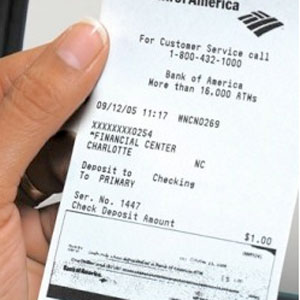 A new study was released today giving new meaning to the phrase “toxic assets.” “On The Money: BPA on Dollar Bills and Receipts” researched by the nonprofit groups Safer Chemicals, Healthy Families and the Washington Toxics Coalition, set out to investigate the extent to which thermal receipt paper containing bisphenol A (BPA) has permeated the market, and whether this hormone-disrupting chemical is escaping onto the money that lies close to these receipts in people’s wallets.
A new study was released today giving new meaning to the phrase “toxic assets.” “On The Money: BPA on Dollar Bills and Receipts” researched by the nonprofit groups Safer Chemicals, Healthy Families and the Washington Toxics Coalition, set out to investigate the extent to which thermal receipt paper containing bisphenol A (BPA) has permeated the market, and whether this hormone-disrupting chemical is escaping onto the money that lies close to these receipts in people’s wallets.
Researchers found that half of the thermal paper receipts tested had large quantities of unbound BPA; 95% of the dollar bills tested positive for lower amounts. Unlike BPA in baby bottles and other products, BPA on thermal paper isn’t chemically bound in any way: it’s a powdery film on the surface of receipts. Data from this report indicate that this highly toxic chemical does not, in fact, stay on the paper, but rather easily transfers to our skin and likely to other items that it rubs against.
Present in 93% of all Americans, scientists studying BPA have hypothesized the major route of human exposure is through food, as BPA is used as a liner in nearly all canned food and beverages. This study indicates that skin absorption from thermal paper receipts with unbound BPA may lead to exposure at levels equivalent to exposure from food sources.
Highlights from the report:
1. About half of thermal paper receipts are made with large quantities of unbound BPA. Receipts made with thermal paper were collected from 22 retailers in 10 states and Washington, D.C. Retailers with BPA-containing receipts included: Safeway, Shaw’s, Meijer, Cub Foods, Sunoco, Kroger, Giant Eagle, H-E-B, Randalls, Fred Meyer, and the Rayburn Café in the U.S. House of Representatives. BPA-free receipts were found at Trader Joe’s, Hannaford, Home Depot, Albertson’s, Ace Hardware, Wal-Mart, Sears, Costco, and the Hart American Grill serving the U.S. Senate.
2. BPA transfers easily from thermal paper receipts to human skin. In tests mimicking typical handling of receipts, BPA transferred from receipts to fingers. Just ten seconds of holding a receipt transferred up to 2.5 micrograms. Researchers transferred much higher amounts, about 15 times as much, by rubbing receipts.
3. Unregulated use of BPA has contaminated our money supply. Since BPA in thermal paper receipts is present in a powdery film, we suspected it could easily travel from those receipts to other objects. BPA was found on 21 of the 22 dollar bills tested. Although the levels of BPA detected on money are much lower than those on receipt paper, the near-ubiquitous presence of BPA on dollar bills indicates that BPA is escaping from products to contaminate other materials in unexpected ways.
“BPA on receipts, dollar bills, and in many other products, is a direct result of the absurdly lax controls on chemicals in the United States,” said Andy Igrejas, Director of the Safer Chemicals, Healthy Families coalition. “The 112th Congress should make reform of the failed 1976 Toxic Substances Control Act a top legislative priority to protect American families for generations to come.”
You can reduce exposure to BPA from receipts by doing the following:
- Refuse a receipt when you can.
- Store your receipts separately, such as in a small envelope, in your wallet or purse.
- Wash your hands after handing receipts or money.
- Keep receipts away from young children.
- Other ways to minimize BPA exposure include:
- Limit your intake of canned foods. For some canned foods, choices in BPA- free cans are available from Eden Foods.
- Choose alternatives to polycarbonate plastic for baby bottles and sports water bottles. For babies, glass and cloudy plastic bottles are better choices. For sports bottles, the best choice is stainless steel.
- Choose powdered rather than liquid infant formula. If you do need liquid formula, use BPA-free containers.
And, Email Congress to Support Safer Chemicals!
Find Out More:
Leave a Reply